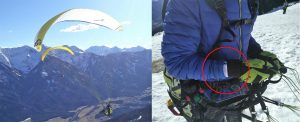RüttelFlug
March 1st, 2017 | Published in Demos, Research
RüttelFlug is a sensory augmentation wearable for paragliders. The intelligent wristband measures vertical speed of the pilot and converts it into intuitively differentiable vibration patterns. As tactile perception is used for information transmission, the pilot can use his other senses, such as the eyes and ears, for experiencing flying.
The key to flying with motorless sports aircraft, such as paragliders and hanggliders, is thermals. Pilots use warm updrafts to gain height and to remain in the air as long as possible. Apart from this basic advantage, however, thermals also pose hazards for paragliders and hanggliders. Cold, descending airflows or abnormal weather conditions may cause extreme descents or climbs. For the controlled use of thermals, the pilot must have access to information about thermal conditions during his flight. For this, he takes a variometer along. It does not only indicate elevation gains, but also measures vertical speed of movements in 3D space. Traditionally, the data collected are transmitted to the pilot in the form of visual or auditive signals and help extend and improve the flight.
Variometers with an auditive output are sources of additional stress due to their comparably loud intrusive noise. Visual output cannot be perceived in every situation. Both negatively affect the flying experience. Here, RüttelFlug is an attractive alternative, as it communicates with the user via an unobtrusive vibrotactile interface. The innovative wearable is based on the principle of sensory augmentation. Vertical speed changes in 3D space (descents and climbs) that normally cannot be felt directly are encoded as vibration patterns that can be perceived. This means:
Information is transmitted to the pilot in the form of sensory output with the help of two vibration actuators. Specific vibration patterns ensure that information is transmitted reliably.
RüttelFlug is designed as a cotton wristband of 6.5 cm width and 3 mm thickness. The electronic components are sewed onto the wristband that is worn by the pilot on the wrist.
Experts took part in the development process. After use,they were interviewed and asked for their experience. In addition, wearability of the wristband was tested in six tests
with experts and non-experts. The following three design principles are applied:
- Minimalistic: Only core functionality, i.e. information about vertical speed.
- Unobtrusive: No distraction of the pilot by e.g. loud noise.
- Low maintenance: The pilot only interacts with the device by switching it on and off.
Research topics
- Tactile Feedback
- Information Services
- Sensory Augmentation
Contact
- Erik Pescara (mail: pescara@teco.edu)
Selected publications
[mendeley type=”groups” id=”8c337d2b-91fd-3f04-9db0-60b09db9bea4″ filter=”author=pescara” sortby=”year” sortorder=”desc”]





